[su_row][su_column size=”1/2″ center=”no” class=””]Mold is one of the most dreaded home invaders, with the ability to destroy the interior of the home while potentially causing serious health issues. While mold can be removed easily from some surfaces, others such as drywall may even be permanently destroyed by a mold infestation. Luckily, if the problem is caught early it may be a small enough project for the homeowner to tackle, requiring no more than standard cleaning tools and some protective gear.[/su_column][su_column size=”1/2″ center=”no” class=””] [/su_column][/su_row]
[/su_column][/su_row]
Table of Contents
Causes of mold growth on drywall
No matter where it springs up, mould is caused by one thing: moisture. The moisture may come from a flood, leaking water or even high humidity in a home. Unfortunately, mould on drywall is usually due to a more serious problem, as opposed to a simply leaky faucet. Because of this the problem may be larger than you can handle and it’s very possible that professionals will need to be consulted. Some of the most common reasons for mold on drywall include a leaking window, a flood in the basement, or leaking from an upstairs bathroom. Always start the assessment by determining the exact cause of the mold on your drywall.
Removing black mold from drywall
The process begins by finding out what’s causing the mould in the first place and fixing the problem. If the issue is a simple leak, make sure it’s completely fixed before you begin removing mold from drywall. At this point you also want to get an idea of how big the affected area is. It’s only recommended for homeowners not trained in black mold removal to tackle areas that are less than ten square feet. Because of the potential health dangers of mold this is a precaution you should take.
Black mildew is the most dreaded type of mould and you should exercise caution if you suspect you have black mold. Determining if you have black mold on drywall can be as easy as checking the pattern it’s growing in, as it always grows in a circular pattern. The process to remove black mold from drywall is the same as with any other fungi.
Another step is to check the damage to the drywall itself. Unfortunately, removing mold from drywall isn’t always possible. If the damage is too extensive the piece will need to be removed and replaced. Check that the drywall isn’t soaking wet, bowed or crumbling before continuing. You must also determine if the mould is on the surface of the drywall, such as on top of paint, or inside of the drywall, which usually occurs with a leaky pipe. As long as the damage isn’t too severe even mold inside drywall can be removed in small chunks.
Black mold on top of the drywall paint
If the mold is on top of the paint, removal is simple.
- Step 1: While wearing gloves and a respirator to protect you from spores, use plastic to cover the floor.
- Step 2: Make a cleaning solution with half a cup of bleach to one gallon of water.
- Step 3: Apply this solution to the mildew and let it sit for at least fifteen minutes.
- Step 4: Next, wash the area with a small amount of dishwashing liquid and clean water, then rinse with water and dry completely. All signs of the mold should be gone.

Black mold inside of the drywall
Mold inside of the drywall will require a larger cleanup effort and removal of small parts of the drywall itself. Begin by wearing protective gear like a respirator, goggles and latex gloves and seal off the area using plastic. This will prevent the spores from spreading.
- Step 1: Place an air scrubber near the affected area to filter the air while you work.
- Step 2: Next, use a hepa vacuum on the surface of the drywall to contain spores, mycelium and mycotoxins.
- Step 3: After this, use the glove box removal method, which requires you to cut a box of plastic that’s four inches longer and wider than the affected area.
- Step 4: Use spray adhesive to apply the plastic box over the moldy drywall. This keeps the mold from entering the air when you begin to cut the drywall.
- Step 5: After this, use a razor to cut the sealed moldy drywall away from the wall, carefully placing it into a garbage bag that’s then sealed.
Black mold on drywall in basement
Basements are one of the most common areas to find mold in a home. Due to the lack of ventilation and humidity, many people develop moisture in their basements that make it the prime breeding ground for all sorts of mold and bacteria.
Black mold is made of a toxic microfungus that can cause a host of health complications in humans. The sticky black spores of Stachybotrys chartarum are ingested or inhaled, leading to chronic respiratory problems and even the development of internal bleeding.
Basement drywall mold isn’t just hazardous; it also spreads fast. Removing the mold as and any traces of bacteria from your home as soon as possible is vital for protecting your property and health.
How to clean and disinfect
 Cleaning and disinfecting the area after you remove the mold is important to make sure all spores are removed. If the area only affected the outside of the drywall, allowing a bleach mixture to sit on the surface for fifteen minutes and wiping down with water is sufficient.
Cleaning and disinfecting the area after you remove the mold is important to make sure all spores are removed. If the area only affected the outside of the drywall, allowing a bleach mixture to sit on the surface for fifteen minutes and wiping down with water is sufficient.
If you needed to remove drywall to get rid of the mold, extra steps should be taken. First, wipe benefact antimicrobial on all of the unaffected drywall near the area. Use a HEPA vacuum on the unaffected areas as well to remove any spores that may be clinging. You’ll also need to HEPA vacuum the entire area you contained, including floors, to make sure no spores get into other areas of the home.
Best way to clean mold stains
In many cases with black mold, the most effective way to remove it completely is with a professional cleaning. Experts have the ability to not just remove the current mold but also identify the source and stop future contamination.
If you’re wondering how to get rid of black mold yourself, the first step is to find out what caused it. Identify any leaks and document the growth pattern of the mold. Is it isolated to one area, or does it spread over time? The location, size and pattern can help you get to the root of the problem so you don’t have any trouble in the future.
In severe cases, drywall may need to be removed and replaced, but to remove stains, a mold killer and cleaner like RMR-86 and RMR-141 RTU (link to Amazon.com) can do the job.
You should always use antibacterial wipes and thoroughly sanitize the drywall when removing mold stains. Even trace amounts of spores will cause the mold to regrow. Benefect antimicrobial and a HEPA vacuum should be used when removing any pieces of drywall to thoroughly remove spores from the area.
Make sure that you protect yourself, too. Wear a face mask and gloves to avoid inhaling any spores, and shower after cleaning.
Prevention tips
Preventing mold requires vigilance. Always check for water damage inside and around your home, as well as leaky pipes and faucets that can cause mold to thrive. Bathrooms, kitchens and basements are the most common places to find mold, so pay careful attention to these rooms. Make sure the humidity level in your home is also appropriate. A humidity level below 60% will usually keep mold at bay, although lower is better. If you find you have a humidity problem in only a single room, buy a dehumidifier. Another great tip to prevent the fungi is to use moisture resistant drywall instead of normal one.
Tools and protective gear
Cleaning up mold requires basic tools like a spray bottle, old rags, bleach, detergent, plastic and garbage bags. You should also use protective gear including high-quality latex gloves, a personal respirator, and safety goggles. This prevents you from breathing in mould spores that can trigger allergies or cause serious health problems.
Warnings
Always use caution around mold, especially if you don’t know what kind it is. Because all molds have the potential to make you sick or trigger allergies, use gloves and a respirator around large amounts of mold. It’s important to ventilate the area you work as well to prevent cleaning fumes from overwhelming you.
Mold Testing and Removal Cost
When the mold in your home is more than you can manage, it’s time to call in some professionals. The cost of black mold removal varies depending on the severity of the infestation and the location in your home.
Complete mold removal typically runs from $500 to $3,000 depending on the extent of the damage.
Professionals can help identify the cause of mold if you’re unable to do so yourself. In some cases, they may remove portions of drywall, and in others, you may need to have your foundation sealed to prevent moisture from building up in your walls.
A repair for this problem ranges between $2,100 to $6,200. While you may be able to have the mold thoroughly removed without sealing your foundation, not doing so when it’s necessary will result in more growth in the future.
Preventative measures are one way to avoid getting black mold in the future after a removal. To learn more about mold removal procedures and to get a free quote, fill in the banner below.
